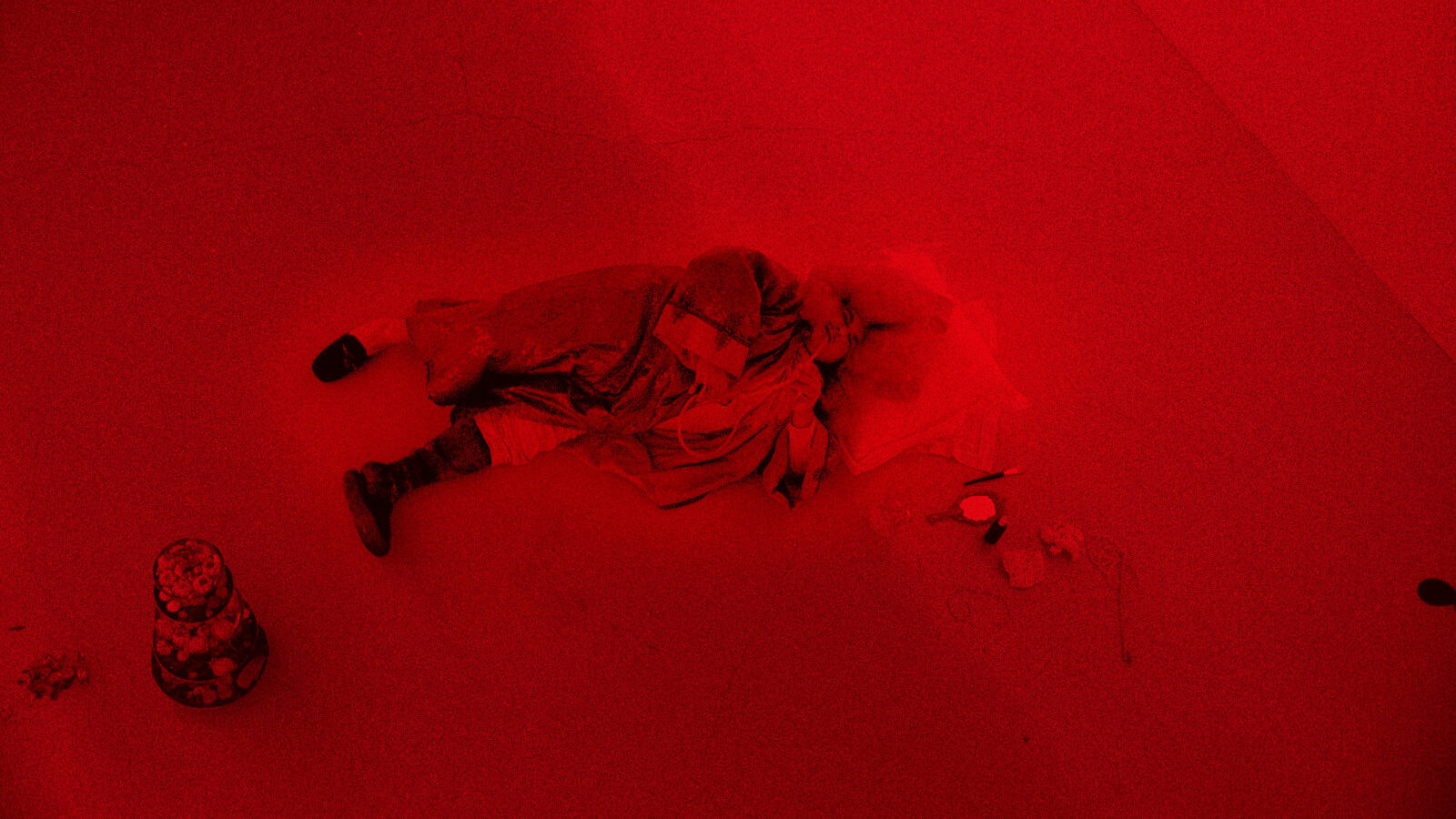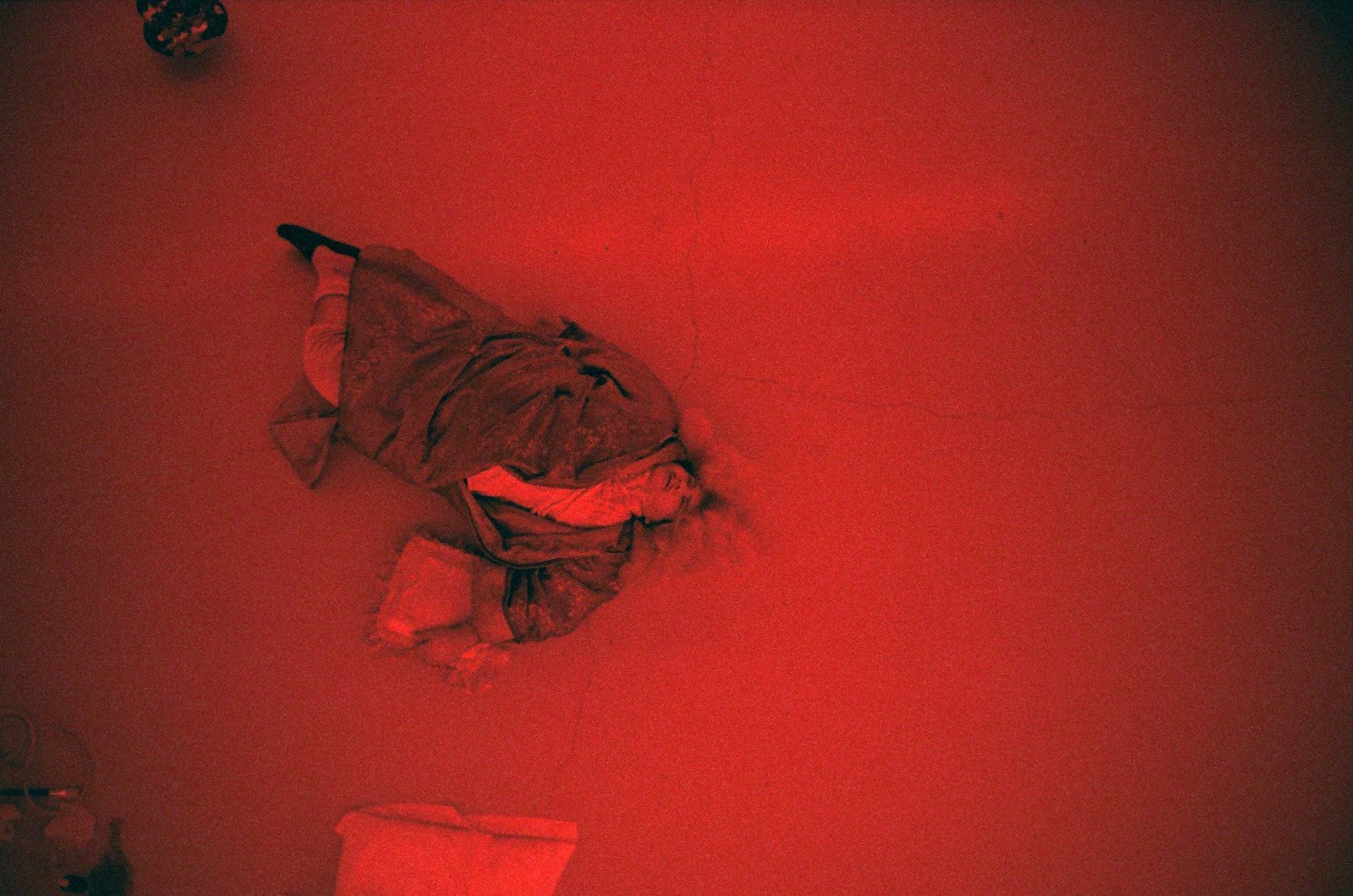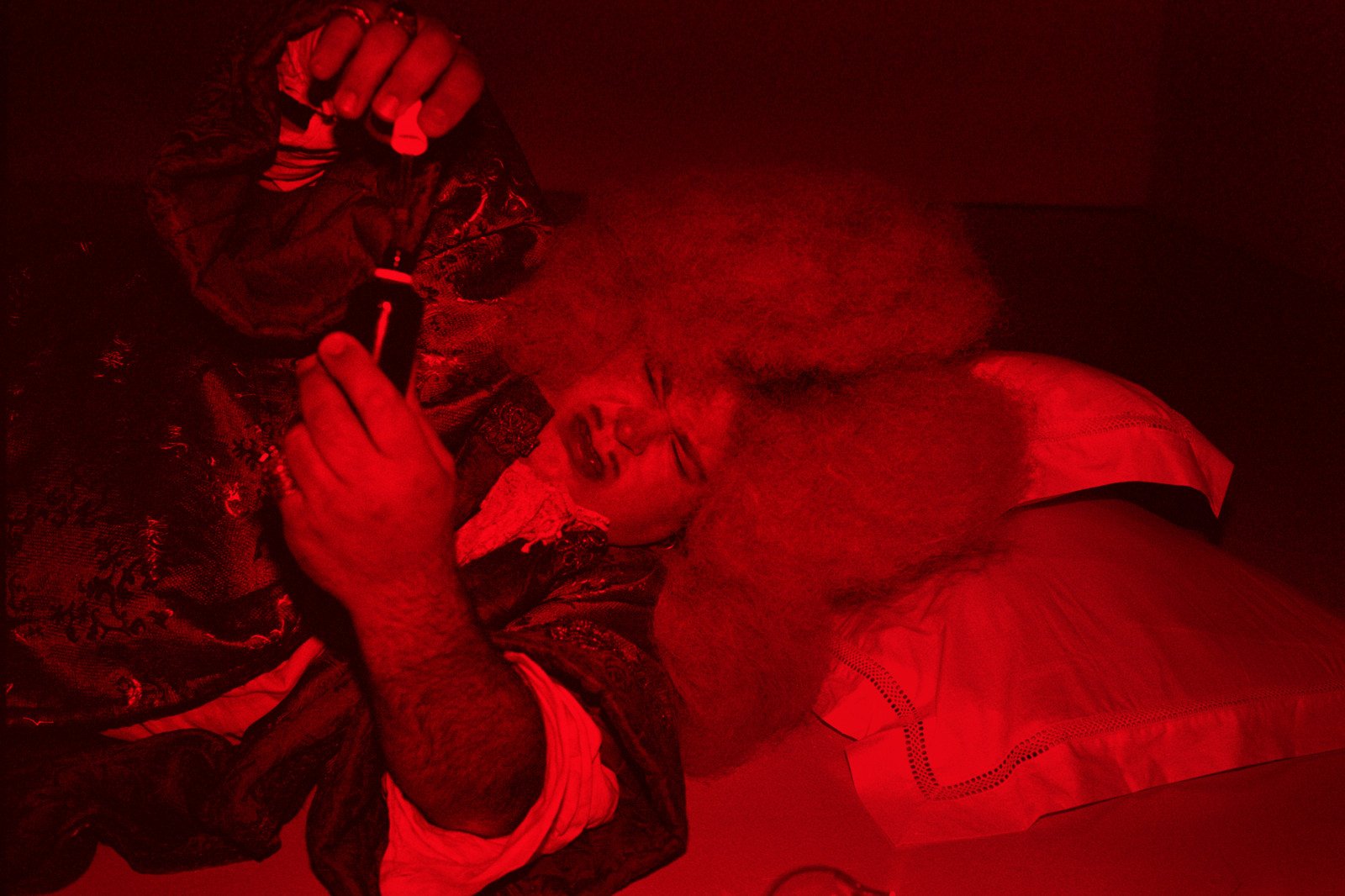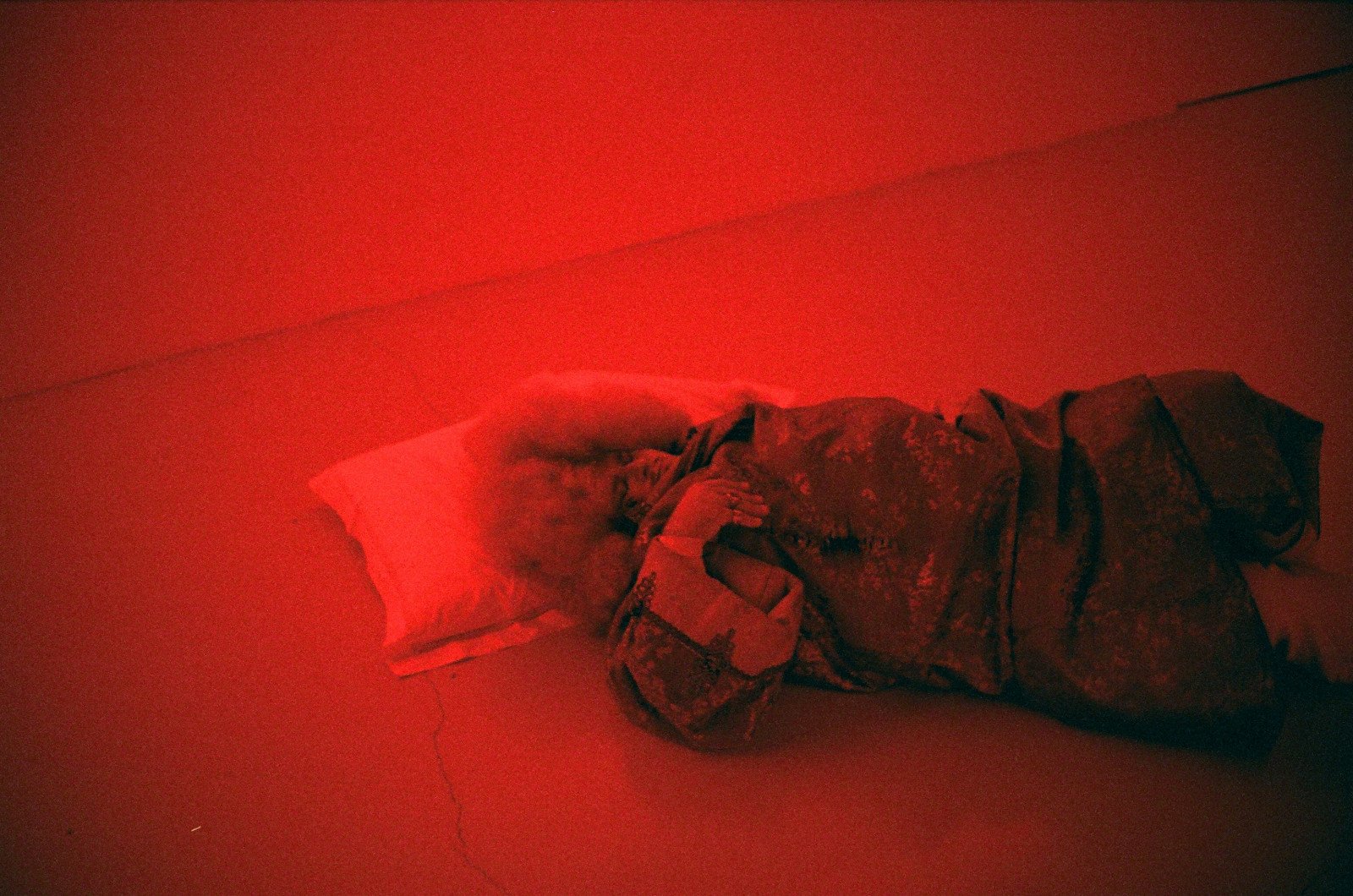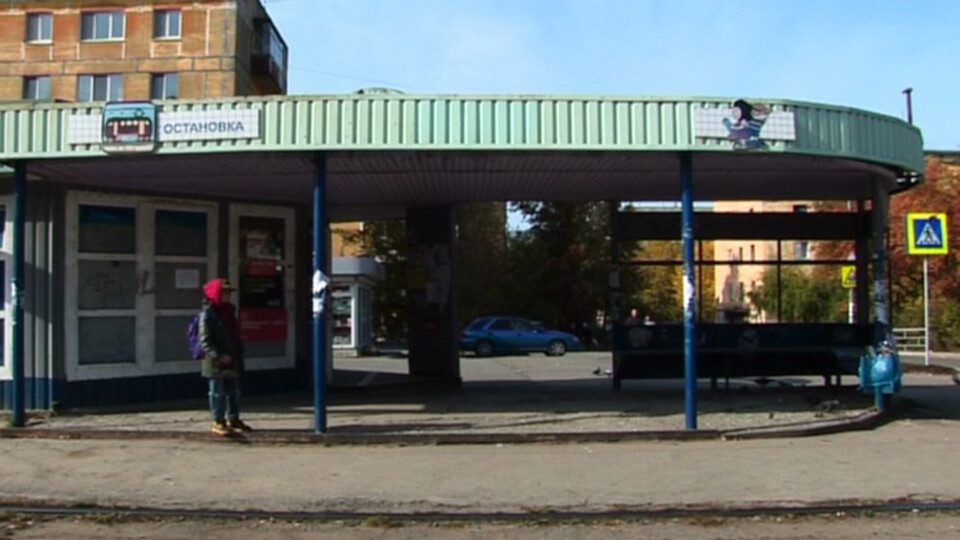A bodily history
Lluís Serrat’s corporeal performance in Roi Soleil (2018).
Film theorist Christian Metz admits that there are several types of true histories, one of which is the so-called “History with a capital H, which records great and crucial events […].”1) At the same time, however, he points out that any kind of ex post reconstruction of events that has ever taken place in the constellations of the ephemeral here and now is always fully constituted by the discourse through which it is described and thus automatically contains a certain admixture of “unreality.”2) It could be added that this is the case regardless of whether it is a retrospective description of, say, the Battle of Waterloo or of our evening walk, for in both cases we view the event only from a distance and, moreover, through a language that is always poorer than the occurrence.3) A far more succinct and resolute questioning, not so much of the veracity as of the very intensity and value of that “History with a capital H” can be seen with Friedrich Nietzsche, speaking through Gilles Deleuze in the monograph Cinema 2: The Time-Image: “I do not believe in great resounding events […]”,4) with which Deleuze sardonically concurs, stating: “There is something peasant in history.”5) It is precisely a certain subversion, a dethroning of the historical icon from an aura-emanating pedestal built on reverence, a kind of liberation from the snares of romanticising history, that could be observed in relation to the figure of the so-called “Sun King” in director Albert Serra’s 2016 film The Death of Louis XIV. But let us not be fooled; Serra does not slip into cheap and pandering caricature – as Deleuze says elsewhere in the pages of Cinema 2, it is not enough, for victory, to parody the cliché.6) Instead, he sets into play a mocking juxtaposition between, on the one hand, the humbly slow pace, the grandiose costumes, and the opulent mise-en-scène of ceremoniously dusky interiors and, on the other, the gradual decay of Louis XIV’s corporeal matter as he dies of ever-worsening gangrene. The flesh is blackening, the tissue is dying, and where else would the decaying, bacteria-ridden leg stand out more sharply than surrounded by the ornate quilts of a sumptuous bed? A certain iconoclasm thus arises as a result of this contrast on the border between an ostentatious style deviating from everyday reality and a purely corporeal event that fervently clings to reality – in the words of Josef Vojvodík, the human being-in-the-world is “[…] first and foremost a physical being.”7)
The concept of the death of this French monarch as a purely physical process without embellishment is apparently, for Serra, particularly inspiring, for he returned to it just a few years later in the significantly more radical Roi Soleil (2018). The depiction of gradual suffering preceding death again forms a kind of backbone of the work, but here the “History with a capital H” serves only as a starting point, from which the filmmaker draws much more loosely than in The Death of Louis XIV. Indeed, the story is devoid of any other narrative lines or historical figures, which The Death of Louis XIV certainly did not lack. Thus, in the vast majority of scenes, we observe the monarch, portrayed by Serra’s frequent collaborator Lluís Serrat, trudging alone through the space toward his inevitable demise, to the accompaniment of naught but anguished interjections such as “Yeyeyeyeye…”, “Oooh!”, and especially the most often repeated “Yooooy…”. The absence of the spoken word in favour of these utterances creates a fascinating contrast with Serra’s film Liberté (2019), in which libertines somnambulantly wandering the nightscape use language as a tool of diversion, of escapism from the currently lived present – through it, they fixate on the past or on hedonistic fantasies, only rarely commenting on present events. In Roi Soleil, the interjections produced by Serrat, on the contrary, always refer to his currently lived states, thus reinforcing his position in the space of “here” and the time of “now”, at the coordinates of which, as will be seen below, Serrat operates. In addition to iconoclasm, a kind of decontextualisation, or perhaps anachronisation, is apparent here as the spaces this time consist not of the period interiors of a French chateau but rather of the sterile, bare, and empty rooms of the present-day gallery Graça Brandão in Lisbon,8) which are drowned in the red of the monochromatic lighting.
As the use of gallery spaces might imply, in the context of Roi Soleil it would be more appropriate to talk about the concept than the plot – Serrat spent exactly seven days in the role of Louis XIV, during which time he inhabited the gallery spaces and performed moments of bodily anguish and pain in a baroque costume.9) The runtime of Roi Soleil, understandably, does not correspond to the length of the performance; it exceeds an hour by roughly one minute. In his introduction to the screening at FID Marseille, the director explained this by saying that it was a kind of “best of” selection of the highlights from the entire week. In this context, we can mention theatre scholar Erika Fischer-Lichte, according to whom every recording of a theatre performance is always deprived of a key attribute of vibrancy (its “liveness”), although she herself admits that it can become an even more distinctive work of art thanks to its transposition by way of of cinematic devices.10)
In accordance with this consideration, Serra certainly does not reduce Roi Soleil to a simple compilation of component passages of the recording of the performance without a shred of inventiveness or originality. He does not try to convey the most authentic experience of the live event but instead presents the viewer with an independent cinematic work. For the sake of stylised spatial compositions, the camera frames the performer from many different angles, instilling us with a specific perspective in contrast to the variable and shifting points of view of the gallery visitors, who appear as staffage only in the final fifteen minutes of the work. The editing creates the impression of continuity between the individual scenes, so it is not obvious how long the gaps between them are in terms of the real-time performance. There are also several instances of music added in post-production, but above all, the viewer of Roi Soleil feels they are witnessing a work that, although unconventional, is complete. In contrast to the gallery visitors’ temporary entries into the sheer transience of a liminal, week-long process, the viewer has the opportunity to be confronted with a work that can be experienced from the beginning to the end, which in this case is represented by the scene in which two men approach the motionless Serrat and pronounce him dead, followed by thunderous applause.
It is clear, however, that despite the purely cinematic medium, Serrat’s performance serves as the central pillar on which Roi Soleil stands, and if we would like to understand this work better, we should pause to examine it. As noted above, in The Death of Louis XIV, gangrene was the primary cause of the monarch’s death. In Roi Soleil, the precise cause of death cannot be determined as it is never explicitly mentioned. Here the dying man’s suffering appears to stem primarily from abdominal pain, for he often holds his belly and, afflicted by some kind of inappetence, is almost unable to consume the biscuit he had previously inspected with epicurean delight. In The Death of Louis XIV, we could observe the progressive growth and spread of the gangrene as a gradual process thanks to the use of special effects, but Serrat cannot rely on anything of the sort during his performance. Everything depends on his acting, his body, and the few props that surround him.
When, for example, Antonin Artaud gave a lecture at the Sorbonne in 1933 entitled “Theatre and the Plague”, which gradually devolved into an acting demonstration of what the death of a person suffering from the black plague looks like,11) it was a sudden and brief performance, the main effect of which could be described as disruptive. But can we speak of disruption if the simulated pre-death moments become for the performer a mundane state in which he remains for an artificially protracted interval of seven days? Serrat was thus faced with a rather unique challenge: a long-term acting improvisation entirely determined by the idea of the internal processes of a body racked by illness, hence not psychological acting but rather its complete opposite – a kind of visceral acting. In this case, the presumed goings-on “under the surface”, which are externalised through behavioural signs, do not represent the delicate processes and movements of the boundless human psyche or soul but rather exclusively bodily processes of a pathological nature. Serrat himself seems to have been truly stripped of psychological depth, as if, in the words of Roland Barthes, he has experienced an “emptying out of interiority to the benefit of its exterior signs […].”12) With no logical trajectory, he shuffles randomly through the space, spends long minutes leaning his head against the wall, massages his temples with an uncomprehending expression, and so on. How far can an actor get thanks to this mental automatism and alternate mode of being based on a corporeal performance? For, as Gilles Deleuze writes, echoing Baruch Spinoza in his monograph Spinoza: Practical Philosophy, “We speak of consciousness and its decrees, of the will and its effects, of the thousand ways of moving the body, of dominating the body and the passions – but we do not even know what a body can do.”13) At the same time, of course, this begs the question as to whether Serrat’s point of reference was the historical figure of Louis XIV or something more difficult to grasp and name; in other words, does he relate his individual actions inductively to the supposed personality of the monarch, or do his gestures, movements, and constant communication without articulated words refer more to the symptoms of (some kind of) illness? And which of these two possibilities is actually more accessible to the actor in the scope of experimental improvisation?
Of course, all of these questions are not easy to answer, but by asking them indirectly Roi Soleil presents us with the idea of a new, different kind of history, diametrically opposed to the “History with a capital H”. It is a phenomenological history fully connected with the subject’s bodily experience, which makes its laws difficult to verbalize – a personal history of the extension of the individual, which can be experienced and felt first-hand but which language cannot deal with. Such a view of the past is understandably incommunicable and extremely subjective because a bodily history is entirely dependent on the phenomenal experience of the specific person. In the context of the torment caused by bodily deterioration, this idea is attached to the vision of a “history of affective transpositions” as described by literary theorist Tomáš Jirsa in his monograph Tváří v tvář beztvarosti [In the face of formlessness] on the basis of his analysis of Richard Weiner’s short story “Smazaný obličej” [The erased face]. It is an opposition to the causal, logical, and harmonious view of the flow of time, which emphasises inexplicable, terrible, and abrupt incursions that completely overwhelm the individual, violently crushing him in their gears.14)
On the other hand, this idea is all too connected with destabilisation at the level of emotionality and does not account for the body as a multiplicity of various processes and actions. In his performance, Serrat seems to concentrate far more on Louis XIV as a sickly body of flesh and bone than as a historical icon with a particular identity that should inform his behaviour or actions. However, if we take that extremely subjective dimension of a bodily history at face value, the realisation emerges that, despite his attempt at a loose actualisation of Louis XIV’s bodily torment, Serrat probably ultimately identifies primarily with his own being-in-the-world. Straddling the line between identification with a historical figure and the symptoms of a particular illness, it is thus himself that he finds. Particularly symptomatic in this regard is a scene lasting several minutes in which he keenly examines his face in a mirror – his own body has become a terra incognita whose qualities demand autotelic exploration. After all, it’s no surprise. Given the very loose outline of the role, the improvisational character of the performance, and its unusually long duration, we are sure to see the emergence of even the most subtle nuances of the split between the actual self and the self playing the role – that schizoid-ontological duality of the actor’s body described by Erika Fischer-Lichte in her book The Transformative Power of Performance as the tension between “being a body” and “having a body”.15) Moreover, Serrat became the de facto main spectator of the entire event, which, instead of an aesthetic artifact, was more an actor’s study and experiment with himself – an exploration of the subtlest nuances of his own face, the possibilities of gesture and movement, or, plain and simple, “[…] what the body can do.”16)
In her book Myslet z druhého místa [To think from second place], philosopher Alice Koubová writes that “[…] the mask, through its duplication into the I and the other I as well as its intensification of the view of the self through extension […], makes it possible to experience and reflect on […] the constitution of the self through otherness and concealment.”17) We can assume that this ability is not the prerogative merely of masks but – due to that schizoid-ontological tension – also of acting as such. Thus, the iconoclastic representation of the bodily history of the dying Louis XIV becomes above all a self-study of Lluís Serrat’s corporeality carried out by the actor himself. For a history of the body is first and foremost a history of the present.
---
Notes
1) JOST, François. Realita/Fikce – říše klamu. Prague: Akademie múzických umění 2006, p. 17.
2) Ibid., p. 17.
3) See, for example: JIRÁNEK, Jaroslav. Tajemství hudebního významu. Prague: Academia, nakladatelství Československé akademie věd, 1979, p. 67.
4) DELEUZE, Gilles. Cinema 2: The Time-Image. Minneapolis: University of Minnesota Press 1997, p. 255..
5) Ibid., p. 255.
6) Ibid., p. 22.
7) VOJVODÍK, Josef. Imagines corporis: Tělo v české moderně a avantgardě. Brno: Host 2006, p. 134.
8) RIVERA, Alfonso. Review: Roi Soleil. [Accessed 22. 9. 2022]. Available at: https://cineuropa.org/en/newsdetail/366283/.
9) Ibid.
10) FISCHER-LICHTE, Erika. „Vnímání a mediálnost“. In: ROUBAL, Jan (ed.). Souřadnice a kontexty divadla: Antologie současné německé divadelní teorie. Prague: Divadelní ústav v Praze 2005, p. 144. Here we can also recall some of Kurt Kren’s structural films presenting fragments of performances by the Viennese Actionists, including 8/64: Ana – Aktion Brus (1964), 6/64: Mama und Papa (Materialaktion Otto Mühl) (1964) or 10/65: Selbstverstümmelung (1965), which are also not mere recordings of actions but rather distinctive montage experiments that fit into the imaginary canon of experimental film classics.
11) Viz – ANGER, Jiří. Melodramatic Imagination and the Theatre of Cruelty: In a Year with Thirteen Moons. Prague 2014. Bachelor’s thesis. Faculty of Arts, Charles University in Prague. Thesis advisor: Petra Hanáková, p. 60. Artaud’s “spicing up” of a lecture was approximated by the Deleuzian Nick Land at the conference Virtual Futures in 1996 when, instead of reading a paper, he gave a delirious performance during which he writhed on the floor emitting all manner of croaks in an attempt at becoming a snake. For more, see, for example: MACKAY, Robin. Nick Land: An Experiment in Inhumanism. [Accessed 22. 9. 2022]. Available at: http://readthis.wtf/writing/nick-land-an-experiment-in-inhumanism/.
12) BARTHES, Roland. Mythologies. New York: Noonday Press 1991, p. 16.
13) DELEUZE, Gilles. Spinoza: Practical Philosophy. San Francisco: City Lights Books 1988, pp. 17–18.
14) JIRSA, Tomáš. Tváří v tvář beztvarosti: Afektivní a vizuální figury v moderní literatuře. Brno: Host 2016, p. 48–50; cf. 159–160.
15) FISCHER-LICHTE, Erika. The Transformative Power of Performance: A New Aesthetics. New York: Routledge 2008, p. 76–77.
16) ANGER, Jiří. Afekt, výraz, performance: Proměny melodramatického excesu v kinematografii těla. Prague: Filozofická fakulta, Univerzita Karlova 2018, p. 27-28.
17) KOUBOVÁ, Alice. Myslet z druhého místa: K otázce performativní filosofie. Prague: Akademie múzických umění v Praze v Nakladatelství AMU 2019, p. 35.

